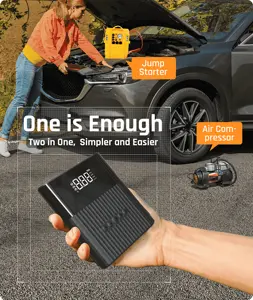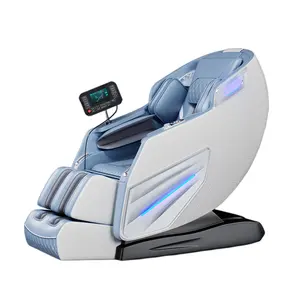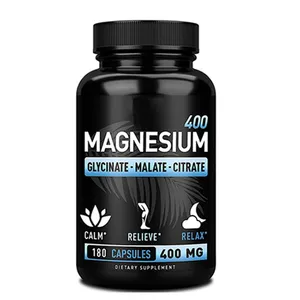ได้รับความนิยมในอุตสาหกรรมของคุณ






แบบพกพา 1000 รอบรถ Jump Starter Air Compressor12V 8000mAh แบตเตอรี่ลิเธียม Power Bank SOS แสงแบตเตอรี่รถยนต์
฿592.56 - ฿925.88
การสั่งซื้อขั้นต่ำ: 500 ชิ้น
การจัดส่งต่อชิ้น: ฿2,853.54







เครื่องอัดอากาศแบบพกพา 150psi และจั๊มสตาร์ทออลอิน 1 แบตเตอรี่แพาเวอร์แบงค์จั๊มสตาร์ทพร้อมเข็มทิศ
฿1,092.53 - ฿1,185.12
การสั่งซื้อขั้นต่ำ: 2 ชิ้น
การจัดส่งต่อชิ้น: ฿1,479.92







เครื่องจั๊มสตาร์ตรถยนต์ขนาดเล็กพกพาได้2000am แอร์คอมเพรสเซอร์และจั๊มพ์สตาร์ทเตอร์
฿1,851.75 - ฿2,444.30
การสั่งซื้อขั้นต่ำ: 1 ชุด

- 10%






Mini ขนาดใหม่เทคโนโลยีสามารถเริ่มต้นรถพองรถชาร์จรถ Jump Starter ดิจิตอล Air การบีบอัด12V Jump starter
พร้อมส่ง
฿1,409.92 - ฿1,509.92
การสั่งซื้อขั้นต่ำ: 1 ชุด
การจัดส่งต่อชิ้น: ฿1,258.45







Yesper 383รุ่นเครื่องจั๊มสตาร์ทแบบพกพาพร้อมเครื่องอัดอากาศ1500A 10000mAh แบตเตอรี่สำรองปั๊มลมรถยนต์บูสเตอร์
฿1,444.36 - ฿2,185.06
การสั่งซื้อขั้นต่ำ: 2 ชิ้น
การจัดส่งต่อชิ้น: ฿755.15







เริ่มต้นกระโดดใหม่ด้วย QC3.0และอินพุต Type-C 12000Mah Mini Jump Starter
พร้อมส่ง
฿888.47 - ฿1,111.05
การสั่งซื้อขั้นต่ำ: 2 ชุด
การจัดส่งต่อชิ้น: ฿1,481.40






Topdon เครื่องจั๊มสตาร์ทรถยนต์ฉุกเฉินขนาดเล็กแบบพกพา12V 16000mah 2200A V2200ได้สูงสุดกล่องใส่แบตเตอรี่สำรองรถยนต์อัตโนมัติ
฿1,925.82 - ฿2,296.17
การสั่งซื้อขั้นต่ำ: 20 ชุด






มินิรถกระโดดเริ่มต้น12โวลต์สถานีพลังงานแบตเตอรี่อัตโนมัติบูสเตอร์แบตเตอรี่ลิเธียมธนาคารอำนาจ
฿1,111.05 - ฿1,296.22
การสั่งซื้อขั้นต่ำ: 1000 ชิ้น






CARKU 12000Mah แบตเตอรี่ขนาดเล็กแบบมัลติฟังก์ชั่นเริ่มต้นสำหรับรถยนต์เบนซิน12V 4000cc และรถยนต์ดีเซล2000cc
฿1,703.61
การสั่งซื้อขั้นต่ำ: 1000 ชุด
การจัดส่งต่อชิ้น: ฿146.29


เครื่องมือไฟฟ้าฉุกเฉิน12000มิลลิแอมป์ชั่วโมงแบบพกพามินิรถกระโดดเริ่มต้น
฿699.96 - ฿740.70
การสั่งซื้อขั้นต่ำ: 300 ชิ้น





OEM มัลติฟังก์ชั่แบบพกพามินิ12V 12000MAh 14000MAh 16000MAh 18000MAh 24000MAh 3000A กระโดดเริ่มต้นสำหรับรถยนต์
฿1,570.28 - ฿2,036.92
การสั่งซื้อขั้นต่ำ: 5 ชิ้น






ตัวเก็บประจุซุปเปอร์12000มิลลิแอมป์ชั่วโมงลิเธียมกระโดดเริ่มต้นมินิมัลติฟังก์ชั่ฉุกเฉินชุดเครื่องมือรถยนต์แบบพกพา Power Bank หลายกระโดดเริ่มต้น
พร้อมส่ง
฿936.99
การสั่งซื้อขั้นต่ำ: 1 ชิ้น
การจัดส่งต่อชิ้น: ฿881.06
การค้นหาที่เกี่ยวข้อง:
สตาร์ทเตอร์ขนาดเล็กสตาร์ทเตอร์มินิกระโดด14000มิลลิแอมป์สตาร์ทเตอร์แบบพกพา12000mahสตาร์ทเตอร์มัลติฟังก์ชั่น12000mahสตาร์ทเตอร์แบตเตอรี่4 in 1ประเภท s 8000mah สตาร์ทเตอร์สตาร์ทเตอร์บอสช์12000mahสตาร์ทเตอร์20800mah12000mah รถพกพากระโดดเริ่มต้นสตาร์ทเตอร์มัลติฟังก์ชั่น18000mahสตาร์ทสตาร์ทเตอร์12โวลต์8000มิลลิแอมป์ตัวเริ่มกระโดดอัตโนมัติ10000mahสตาร์ทเตอร์มัลติฟังก์ชั่น8000mah12000mah สตาร์ทเตอร์แบบพกพาสตาร์ทเตอร์36000mah






มัลติฟังก์ชั่ mini แบบพกพา jump starter 12 v diy jump starter car power bank แบตเตอรี่
฿1,074.02 - ฿1,259.19
การสั่งซื้อขั้นต่ำ: 2 ชุด






รถมินิแบบพกพาเริ่มต้นกระโดด4 USB 12000มิลลิแอมป์ชั่วโมงธนาคารอำนาจรถจัมเปอร์เริ่มต้น
฿1,111.05 - ฿1,259.19
การสั่งซื้อขั้นต่ำ: 1 ชิ้น






เครื่องจั๊มสตาร์ทแบตเตอรี่ขนาดพกพาขนาดเล็ก12000 mAh เครื่องจั๊มฉุกเฉิน12V 1200A เหมาะสำหรับรถยนต์เบนซินแบบมัลติฟังก์ชั่น
฿639.97 - ฿909.58
การสั่งซื้อขั้นต่ำ: 1 ชิ้น

รถฉุกเฉินแบบพกพาธนาคารพลังงานแบตเตอรี่ชาร์จ12000มิลลิแอมป์ชั่วโมงมินิกระโดดเริ่มต้นรถกระโดดเริ่มต้น
฿1,031.43 - ฿2,194.32
การสั่งซื้อขั้นต่ำ: 300 ชิ้น






เครื่องจั๊มสตาร์ทรถขนาดเล็กแบบพกพา12000MAh,เครื่องชาร์จแบตเตอรี่รถยนต์ฉุกเฉิน12V
฿2,148.03 - ฿2,777.62
การสั่งซื้อขั้นต่ำ: 2 ชุด






อัตโนมัติกำไรรถยนต์ขนาดเล็กเริ่มต้นกระโดดมัลติฟังก์ชั่12000มิลลิแอมป์ชั่วโมงคิงเพาเวอร์
฿814.77 - ฿851.81
การสั่งซื้อขั้นต่ำ: 200 ชุด






Peak 800A รถ เพิ่มพลังงานฉุกเฉิน แบตเตอรี่ กระโดดเริ่มต้น มินิสตาร์ทรถ จากนั้นพกพาไฟฉาย LED
฿880.69 - ฿990.69
การสั่งซื้อขั้นต่ำ: 10 ชิ้น






การออกแบบผลิตภัณฑ์ใหม่ที่ไม่ซ้ํากันมินิบูสเตอร์กระโดดเริ่มต้น 12000mah 450A ไฟฟ้ากลางแจ้งสตาร์ทฉุกเฉิน 12V อัตโนมัติ
฿1,356.22 - ฿1,627.32
การสั่งซื้อขั้นต่ำ: 10 ชิ้น




Boltpower G40สตาร์ตเตอร์แบตเตอรี่ลิเธียมขนาดมินิ12000mAh
฿833.29 - ฿1,129.57
การสั่งซื้อขั้นต่ำ: 1 ชุด
การจัดส่งต่อชิ้น: ฿469.61






รถกระโดดแบตเตอรี่เริ่มต้น V10 Rony กระโดดเริ่มต้น12โวลต์เครื่องยนต์อัตโนมัติ,มาเลเซียประเทศไทยสหรัฐร้อนขายมินิรถกระโดดเริ่มต้น
฿888.84 - ฿1,036.98
การสั่งซื้อขั้นต่ำ: 100 ชิ้น






Powkey พาวเวอร์แบงค์ขนาดเล็กพกพา12000MAh,พาวเวอร์แบงค์ Dc/ac สำหรับชาร์จโทรศัพท์มือถือสตาร์ทรถแบบพกพาสำหรับใช้ในกรณีฉุกเฉิน
฿1,278.08 - ฿1,651.39
การสั่งซื้อขั้นต่ำ: 100 ชุด
การจัดส่งต่อชิ้น: ฿511.09






เครื่องจั๊มสตาร์ทรถ4อิน1พร้อมที่เติมลมในรถแบตเตอรี่สำรองขนาดมินิ12000มิลลิแอมป์มาใหม่พร้อมไฟฉุกเฉิน
฿1,296.22 - ฿1,407.33
การสั่งซื้อขั้นต่ำ: 100 ชิ้น




กระโดดเริ่มต้น12000มิลลิแอมป์ชั่วโมงมินิกระโดดเริ่มต้น12โวลต์แฟลช Sos แสงมัลติฟังก์ชั่กระโดดเริ่มต้นสำหรับรถ
฿1,036.98 - ฿1,296.22
การสั่งซื้อขั้นต่ำ: 1 ชุด






รายชื่อสินค้าใหม่มินิทนทาน5 In 1ธนาคารพลังงานรถกระโดดเริ่มต้น12000มิลลิแอมป์ชั่วโมงเครื่องมือฉุกเฉินกระโดดเริ่มต้น
฿1,111.05 - ฿1,446.22
การสั่งซื้อขั้นต่ำ: 2 ชุด






12000Mah รถแบตเตอรี่มินิดิจิตอลจอแสดงผลไฟฟ้าปั๊มลมคอมเพรสเซอร์ Jump Starter 12V 1000A เริ่มต้น
฿1,536.95 - ฿2,148.03
การสั่งซื้อขั้นต่ำ: 2 ชิ้น






จั๊มสตาร์ทใหม่ปี 2024 พร้อมอินพุต Type-C 12000mAh มินิจั๊มสตาร์ท
พร้อมส่ง
฿1,481.40 - ฿1,666.57
การสั่งซื้อขั้นต่ำ: 2 ชุด
การจัดส่งต่อชิ้น: ฿2,588.74






HF600แบตเตอรี่สำรองแบบพกพา3-in-1, แบตเตอรี่สำรองฉุกเฉินแบบพกพาและรถมินิพร้อมฟังก์ชันเครื่องดูดฝุ่น
฿1,370.29 - ฿1,477.70
การสั่งซื้อขั้นต่ำ: 100 ชุด






ที่มีคุณภาพสูงรถกระโดดเริ่มต้น1000a มัลติฟังก์ชั่มินิอัตโนมัติกระโดดธนาคารอำนาจเริ่มต้นด้วยไฟ Led
฿1,388.81 - ฿1,555.47
การสั่งซื้อขั้นต่ำ: 500 ชิ้น
การจัดส่งต่อชิ้น: ฿61.48






เครื่องจั๊มสตาร์ทรถขนาดเล็ก12000มิลลิแอมป์พร้อมที่เติมลมยางและเครื่องจั๊มแบตเตอรี่สำรองอเนกประสงค์
พร้อมส่ง
฿1,859.15 - ฿2,255.43
การสั่งซื้อขั้นต่ำ: 1 ชุด
การจัดส่งต่อชิ้น: ฿4,147.91






SPY มินิแบบพกพาสถานีพลังงานแบตเตอรี่บูสเตอร์ญี่ปุ่นรถกระโดดเริ่มต้น1500a 12000มิลลิแอมป์ชั่วโมงธนาคารพลังงานธนาคารรถกระโดดเริ่มต้น
฿1,329.56 - ฿1,588.80
การสั่งซื้อขั้นต่ำ: 1 ชุด






เครื่องจั๊มแบตเตอรี่ฉุกเฉินแบบพกพาขนาดเล็ก12000mAh 12V สำหรับรถยนต์เครื่องจั๊มแบตเตอรี่สำรองพลังงานรถยนต์
฿611.08 - ฿666.63
การสั่งซื้อขั้นต่ำ: 50 ชุด






เครื่องจั๊มแบตเตอรี่ลิเธียม12V แบบพกพาเครื่องจั๊มแบตเตอรี่ลิเธียมเครื่องอัดอากาศสำหรับรถยนต์
฿722.18 - ฿1,092.53
การสั่งซื้อขั้นต่ำ: 10 ชิ้น






2366มาใหม่กับฉุกเฉินที่น่ากลัวธนาคารพลังงาน USB แบตเตอรี่บูสเตอร์มินิ12000มิลลิแอมป์ชั่วโมงรถกระโดดเริ่มต้น
฿1,185.12 - ฿1,222.15
การสั่งซื้อขั้นต่ำ: 2 ชุด






HUIHAO R&D สตาร์ทลิเธียม-ใหม่ brights ขนาดกะทัดรัด 12000mah มินิสตาร์ทรถและโซล่าเซลล์และสตาร์ทแบบพกพาในราคาที่ดี
฿777.74 - ฿1,092.53
การสั่งซื้อขั้นต่ำ: 2 ชุด






รถมินิแบบพกพากระโดดเริ่มต้นแบตเตอรี่ฉุกเฉิน12โวลต์แบตเตอรี่ฉุกเฉินรถกระโดดเริ่มต้น12000มิลลิแอมป์ชั่วโมง
฿662.93 - ฿737.00
การสั่งซื้อขั้นต่ำ: 50 ชิ้น





ธนาคารพลังงานแบบพกพาเครื่องมือยานพาหนะฉุกเฉิน12โวลต์บูสเตอร์รถแบตเตอรี่ลิเธียมมินิกระโดดเริ่มต้น
฿1,259.19 - ฿1,333.26
การสั่งซื้อขั้นต่ำ: 1 ชุด






1200a สูงสุดที่แข็งแกร่งมัลติฟังก์ชั่รถบรรทุกขนาดเล็ก 12V ดีเซลแก๊สแบตเตอรี่ลิเธียม Booster รถเก็บพลังงานแบบพกพา Jump Starter
฿629.60 - ฿888.84
การสั่งซื้อขั้นต่ำ: 1 ชิ้น
การจัดส่งต่อชิ้น: ฿1,839.53






AVAPOW NP2 ตัวเก็บประจุซุปเปอร์ 12000mah ลิเธียมจั๊มสตาร์ทเตอร์มินิมัลติฟังก์ชั่ฉุกเฉินชุดเครื่องมือจั๊มสตาร์ทเตอร์
฿1,640.28 - ฿1,711.01
การสั่งซื้อขั้นต่ำ: 1000 ชิ้น
การจัดส่งต่อชิ้น: ฿527.75
หมวดหมู่ยอดนิยม
เกี่ยวกับ สตาร์ทเตอร์มินิกระโดด12000มิลลิแอมป์
สตาร์ทเตอร์มินิกระโดด12000มิลลิแอมป์ ไม่ใช่เรื่องใหม่สำหรับคนทั่วไปในปัจจุบันและไม่ถือว่าเป็นสิ่งต้องห้ามอีกต่อไป หากคุณกำลังมองหาความสุขสุดท้ายนี้คุณต้องตรวจสอบความยิ่งใหญ่ คอลเลกชัน สตาร์ทเตอร์มินิกระโดด12000มิลลิแอมป์ ที่ Alibaba.com เหล่านี้ยั่วยวนและโค้ง สตาร์ทเตอร์มินิกระโดด12000มิลลิแอมป์ คุ้มค่ากับเงินทุกบาทและมั่นใจว่าจะทำให้ค่ำคืนนี้พิเศษสำหรับคุณ ตุ๊กตาเหล่านี้มีลักษณะเหมือนจริงตั้งแต่ขนไปจนถึงปลายเท้าในทุกแง่มุม
ไม่ว่าคุณจะเป็นคนขี้เหงาที่กำลังมองหาคู่ชีวิตที่เหมือนมีชีวิตหรือคู่รักที่ต้องการเติมชีวิตชีวาให้กับชีวิตคุณสามารถใช้สิ่งเหล่านี้ได้ . สตาร์ทเตอร์มินิกระโดด12000มิลลิแอมป์ สำหรับจุดไฟนั้น ที่งดงามเหล่านี้ สตาร์ทเตอร์มินิกระโดด12000มิลลิแอมป์ สามารถปรับแต่งได้ตามความคาดหวังของคุณ น่าทึ่งเหล่านี้ สตาร์ทเตอร์มินิกระโดด12000มิลลิแอมป์ มีให้เลือกทั้งชายและหญิงและทำจากซิลิโคนเกรดยาเพื่อความปลอดภัยในการใช้งาน รับตอนนี้และเพลิดเพลินไปกับค่ำคืนแห่งความหลงใหลและไฟ
Alibaba.com ขอเสนอสิ่งที่น่าทึ่งเหล่านี้ สตาร์ทเตอร์มินิกระโดด12000มิลลิแอมป์ ในทุกรูปร่างขนาดและชาติพันธุ์ ไม่ว่าความต้องการของคุณสำหรับไฟล์. สตาร์ทเตอร์มินิกระโดด12000มิลลิแอมป์ คุณสามารถหาได้ทั้งหมดบนไซต์ เหล่านี้ สตาร์ทเตอร์มินิกระโดด12000มิลลิแอมป์ ได้รับการขึ้นรูปโดยช่างฝีมือที่ดีที่สุดและทุกรายละเอียดที่ซับซ้อนจะได้รับการตรวจสอบอย่างละเอียด ตุ๊กตาเหล่านี้มีดวงตาผมเล็บและส่วนอื่น ๆ ของร่างกายคล้ายกับคนในชีวิตจริง
Alibaba.com ให้บริการที่หลากหลาย สตาร์ทเตอร์มินิกระโดด12000มิลลิแอมป์ ที่สามารถช่วยคุณซื้อผลิตภัณฑ์ที่เหมาะสมกับงบประมาณของคุณและข้อกำหนดอื่น ๆ ผลิตภัณฑ์เหล่านี้ปลอดภัยต่อการใช้งานได้รับการรับรองและเป็นมิตรกับสิ่งแวดล้อม มีคำสั่งซื้อ OEM สำหรับผลิตภัณฑ์เหล่านี้
ไม่ว่าคุณจะเป็นคนขี้เหงาที่กำลังมองหาคู่ชีวิตที่เหมือนมีชีวิตหรือคู่รักที่ต้องการเติมชีวิตชีวาให้กับชีวิตคุณสามารถใช้สิ่งเหล่านี้ได้ . สตาร์ทเตอร์มินิกระโดด12000มิลลิแอมป์ สำหรับจุดไฟนั้น ที่งดงามเหล่านี้ สตาร์ทเตอร์มินิกระโดด12000มิลลิแอมป์ สามารถปรับแต่งได้ตามความคาดหวังของคุณ น่าทึ่งเหล่านี้ สตาร์ทเตอร์มินิกระโดด12000มิลลิแอมป์ มีให้เลือกทั้งชายและหญิงและทำจากซิลิโคนเกรดยาเพื่อความปลอดภัยในการใช้งาน รับตอนนี้และเพลิดเพลินไปกับค่ำคืนแห่งความหลงใหลและไฟ
Alibaba.com ขอเสนอสิ่งที่น่าทึ่งเหล่านี้ สตาร์ทเตอร์มินิกระโดด12000มิลลิแอมป์ ในทุกรูปร่างขนาดและชาติพันธุ์ ไม่ว่าความต้องการของคุณสำหรับไฟล์. สตาร์ทเตอร์มินิกระโดด12000มิลลิแอมป์ คุณสามารถหาได้ทั้งหมดบนไซต์ เหล่านี้ สตาร์ทเตอร์มินิกระโดด12000มิลลิแอมป์ ได้รับการขึ้นรูปโดยช่างฝีมือที่ดีที่สุดและทุกรายละเอียดที่ซับซ้อนจะได้รับการตรวจสอบอย่างละเอียด ตุ๊กตาเหล่านี้มีดวงตาผมเล็บและส่วนอื่น ๆ ของร่างกายคล้ายกับคนในชีวิตจริง
Alibaba.com ให้บริการที่หลากหลาย สตาร์ทเตอร์มินิกระโดด12000มิลลิแอมป์ ที่สามารถช่วยคุณซื้อผลิตภัณฑ์ที่เหมาะสมกับงบประมาณของคุณและข้อกำหนดอื่น ๆ ผลิตภัณฑ์เหล่านี้ปลอดภัยต่อการใช้งานได้รับการรับรองและเป็นมิตรกับสิ่งแวดล้อม มีคำสั่งซื้อ OEM สำหรับผลิตภัณฑ์เหล่านี้











